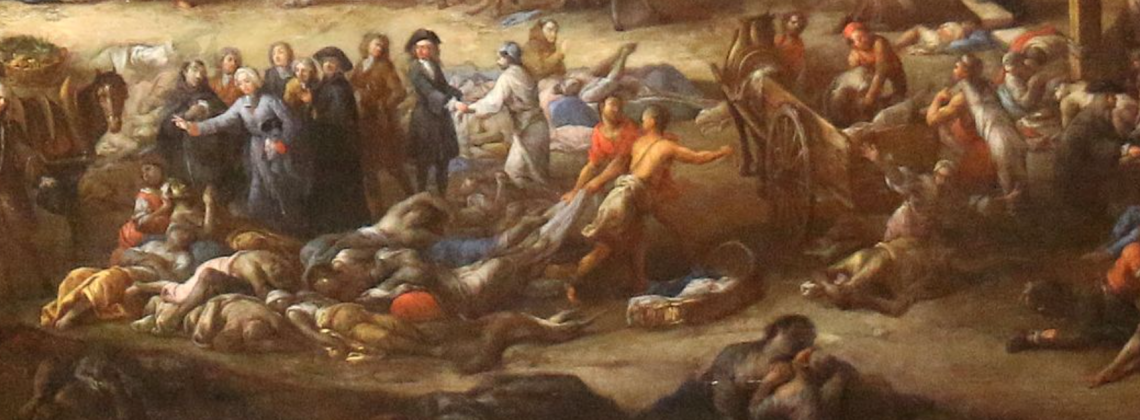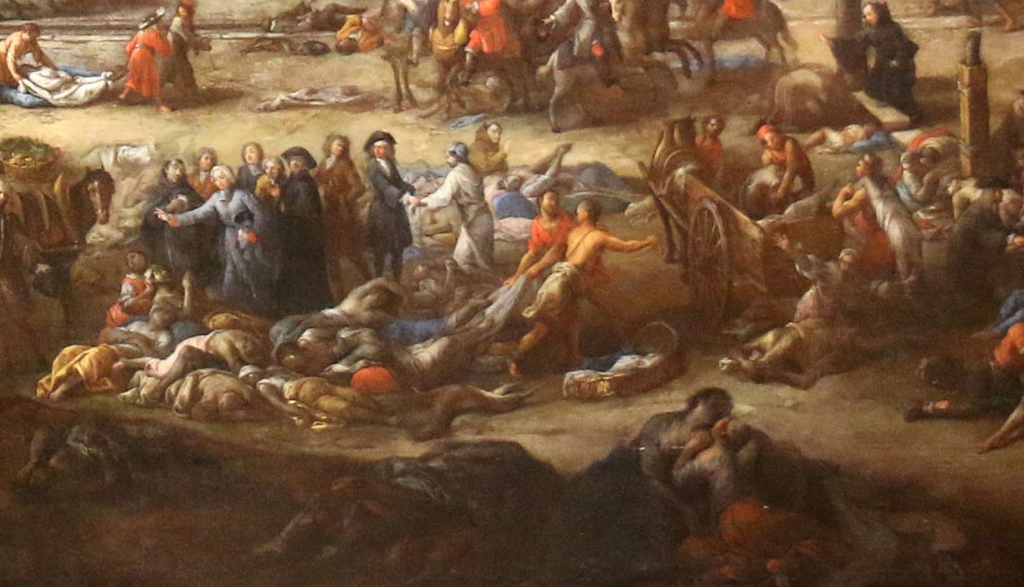

From much death came much centralization
The Great Plague Scare of 1720: Disaster and Diplomacy in the Eighteenth-Century Atlantic World by Cindy Ermus. Cambridge University Press, 2022. 258 pp., $39.99
Imagine the following: A deadly disease arrives at a port located along the trade routes to the east. It quickly spreads beyond city gates and into the surrounding countryside. Fearing economic disaster, local authorities attempt to hide the truth about the scale of the disaster for as long as possible. Though successful in the short term, word gets out nevertheless—in part because of panicked refugees fleeing infection. Soon, central governments of surrounding territories step in, asserting their greater control, all in the name of public health. Quarantines are imposed, health certificates issued, and movement is restricted. In some places, resistance to these measures organically arises.
Given our recent experiences during the COVID-19 pandemic, the above sequence might appear all too familiar. However, the scenario describes events three hundred years before COVID, when the plague struck southern France. It is this earlier time of crisis, a time not well remembered outside the world of academic historians, that Cindy Ermus explores in The Great Plague Scare of 1720.
The story begins in summer of 1720, when the plague appeared in France’s major Mediterranean port of Marseille. Tradition states that the disease was brought by a trading ship, the Grand Saint-Antoine, which had been sailing in the eastern waters of the Mediterranean Sea. By the end of the summer, the plague spread into Provence, the region surrounding Marseille. Before the crisis ended two years later, around 126,000 people had perished, including about half of Marseille’s pre-plague population of 90,000.
Though Europeans could not know it at the time, the pandemic that struck southern France in the early 1700s was one of the last major waves of what scholars now term the Second Pandemic, which first struck Europe with the Black Death in the 1340s. From the mid-fourteenth through the late-eighteenth century, plague epidemics struck Europe about once every one or two generations. Then, by the end of the 1700s, the plague disappeared from the European disease environment. The Plague of Provence thus marked a crucial ending.
And yet the Plague of Provence struck during a period of major transitions and transformations. Five years earlier, Louis XIV, France’s Sun King, the prototypical absolute monarch, had died after seventy-two years on the throne. His last decades had been marked by major wars and concerted efforts at state centralization. After the old king’s death, France witnessed a cultural loosening and flowering that helped lay the foundations for the Enlightenment, a movement that celebrated the use of reason in improving the human world and a movement that self-consciously critiqued received traditions. Economic growth, particularly as a result of expanding global empires, also contributed to these new understandings of the world. The Plague of Provence, therefore, also struck during a moment of beginnings.
Ermus stresses the beginnings over the endings. She presents the 1720 outbreak as the moment recognizably modern responses to disaster first emerged. Rather than offering a broad narrative of the plague in Marseille and beyond, Ermus instead focuses closely on official responses to the disaster. She argues that the plague encouraged what she terms “disaster centralization,” meaning a movement away from local disaster management to central state leadership and direction. While acknowledging the complications of the process, Ermus states that the Plague of Provence proved the “largest most notable early example of a concentrated, transnational effort by the heads of Europe’s emerging nation states to oversee the handling of a major public health crisis or disaster.” Ermus also notes that those concentrated, transnational efforts had effects far outside the realm of public health. Such efforts also had diplomatic and economic intentions and impacts. She writes that the “emergency in 1720—in this case, the mere threat of plague beyond the borders of France—presented rulers across Europe with opportunities to flex their centralizing muscles in the name of public health.” Not surprisingly, “parts of Europe emerged from the plague more centralized, bureaucratized, and interconnected.”
As noted, Ermus uses a transnational approach, studying responses to the plague across, in her words, an “invisible commonwealth” of port cities. All her chapters function as related case studies; each discusses in detail official responses in a variety of places across Europe and the Atlantic Ocean to the Plague of Provence and the various ways in which rulers effected greater centralized control. She opens by looking at France, offering a brief overview of the course of the plague and laying foundations for discussing her concept of disaster centralism by examining French efforts to stop the spread of the disease. She then shifts focus to Italy, specifically the mercantile city-state of Genoa, long a model for how to respond effectively to plague, followed by a turn to London, and the policies undertaken by newly installed Hanoverian monarch George I’s government. Here Ermus shows how the Plague of Provence became part of changing discussions of disease in early-Enlightenment Britain. She also explores how strict official British public health measures exacerbated disruptions at the same time as a major economic bust now known as the South Seas Bubble and so triggered widespread resistance in the name of protecting liberties. King George’s government backed down.
In the following chapter on Spain, Ermus studies a more successful example of disaster centralization. The new ruling dynasty, the Bourbons, saw in an aggressive public health campaign a means of rebuilding Spanish power versus its rivals after a period of perceived political and economic decline. From Spain, the setting shifts across the Atlantic Ocean to the French Caribbean colony of Martinique. In detailing responses of French and Spanish colonists to central demands, Ermus exposes the limits to disaster centralization imposed by physical distance from the mother country. Effective centralization, she notes, ultimately depended on central demands being carried out. In the colonies, these orders were largely ignored, as they were viewed as interfering with local economic demands and desires, notably smuggling with other colonies. According to Ermus, during the Plague of Provence, colonial economic life continued much as before. Taken together, Ermus’ chapters illustrate that while European rulers may have shared a common ambition to further centralize their powers during the Plague of Provence, results varied depending on circumstances.
Overall, Ermus’ book reflects clearly its origins as a Ph.D. dissertation written for a specialized audience. Thick footnotes line the bottom of each page, testifying to her extensive research in around twenty European archives. Rather than offering a broad narrative of events, Ermus maintains an academic tone and structure, stating a tightly focused argument in the introduction and then developing and proving that argument across the chapters. Perhaps because of her tight focus on disaster centralization, Ermus presupposes a high degree of background knowledge on the part of readers. Those less well versed in the details of eighteenth century European political, economic, and cultural developments may find themselves turning to an encyclopedia for explanations. In addition, Ermus’s tight focus on official responses minimizes discussion of related issues. The 1720 plague was not the first major disaster European rulers confronted in the eighteenth century. In 1709, a harsh winter led to harvest failures and, in some regions, famine. Historians estimate that perhaps as much as five percent of France’s total population, for one example, died in the aftermath. The French government did take steps to address the crisis, albeit mostly unsuccessfully. Comparisons with these earlier responses to disaster might have proved fruitful here. Also, in building a case for incipient modernity, Ermus talks rather little about more traditional responses to the Plague of Provence, and in particular to religious responses like ritual processions and acts of communal prayer beseeching God to end the pandemic. At times, especially in her chapter on southern France itself, Ermus hints that these local reactions so reminiscent of medieval precedents may have been as crucial for contemporaries as the seemingly more modern centralizing official policies.
In sum, Ermus offers readers a thought-provoking exploration into a world undergoing profound transformations while encountering a pandemic, a world that our own world echoes. Ermus raises pivotal questions about how governments respond to such disasters and about the intended and unintended consequences of those responses. She comments that “the motivation behind a society’s responses to public health crises are not as simple as doing everything possible to save lives.” Moreover, connecting the eighteenth century to today, she asserts that the “considerations that come into play as leaders deliberate how to best manage an epidemic . . . vary from case to case, but the fact that saving lives is not the only—or, at times, even the primary—concern is unchanging.” Three centuries ago, as Ermus relates, Europe’s rulers responded to the health crisis confronting them in ways that strengthened their power over society. One wonders how the responses of our governments to the pandemic we experienced will look in another three centuries.
Charles Lipp is Professor of History at the University of West Georgia and the author of Noble Strategies in an Early Modern Small State: The Mahuet of Lorraine.
Image: Michel Serre – Painting of Marseille during the Great Plague. Public Domain